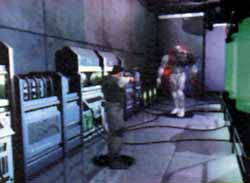The industry, journalists, gamers, the public, everyone's talking about the relations between videogames and cinema. These links are very much real, and much more complex than they seem. Dive into the analysis.
ON THE FUNCTIONAL AND DRAMATIC USE OF CINEMATOGRAPHIC LANGUAGE IN VIDEOGAMES
Since
3D came out in the open, everyone has been talking a lot of nonsense about
the gaming experience turning into something close to cinema. Although
such allegations might contain some modicum of truth, they are all too
superficial : just because a game features camera movements and narrative
cut-scenes doesn't mean it resembles cinema. The apparent similarities
between these two media rely on pure logic : in order to represent a virtual
or real environment, a viewpoint is needed -whether it belongs to the
director, the painter, the graphic artist or, in our present case, to
the game-designer. As cinema provided a strong basis to depict a setting
and tell stories through the use of the camera, videogaming naturally
drew inspiration from it in such a way as to present virtual worlds in
the clearest and most convenient manner.
Consequently,
horizontal and vertical scrollings in 2D games, as well as camera shots
following the character in games based on a third-person view are equivalent
to the art of the tracking shot. As for the first-person view (utilized
in Wolfenstein 3D, Doom, Quake, and their numerous followers), it is nothing
more than a virtual transposing of the subjective view in cinema. The
functional influence cinema had on videogames is at times more subtle
: in Zelda : Majora's Mask, the camera frequently focuses on specific
elements in order to underline their importance (for instance, zooming
in and out to show the way which was opened after a switch has been activated).
 Resident Evil
Resident Evil
Yet the influence of film language on videogames goes beyond mere aspects of gameplay mechanism. The narrative -even though the term hardly applies to videogames- has learned a lot from the movies. Much like its 'real' counterpart, a virtual camera has an important part to play in dramaturgy, an obvious example being the oppressive camera angles in Resident Evil (the frightening high-angle shot of the elevator scene). Last but not least, cut-scenes might represent the closest thing there is to cinema in a game (whether as an introduction, a conclusion or implemented in the flow of the game). Those are short computer generated movies, sometimes featuring real actors as in Riven or Wing Commander (with, for the latter, the notable participation of Jedi Knight Mark Hamill).
ON THE DANGERS OF CUT-SCENES
Cut-scenes,
which clearly doesn't have anything to do with videogames, might be the
most misused and excessive element in contemporary videogaming. Some developpers
seem to forget there is an art of writing videogames which doesn't rely
that much on cinema. SquareSoft, notably with Final Fantasy 8 and
the infamous The Bouncer, totally forgot the fact that a game cannot be
summed up to a succession of cut-scenes ponctuated with vague gaming sequences.
Cryo is another example, a developer which favors the esthetic aspect
and density of the narrative over gaming value. As for the introduction
to the nevertheless impressive Shenmue by SEGA, it represents a landmark
in the history of disappointing cut-scenes : an endless and poorly shot
introduction (sideways tracking during the dialogues, constant switching
viewpoints and ridiculous slow-motion sequences featuring after-imagery
effects, a vain entreprise of John Woo plagiarism), followed during the
game by dialogues occuring every five steps which convey a depressing
staccato rythm to the action.
"A videogame is a network in which the player is free to choose his own
path", explains Gérard Delorme from movie-magazine Premiere. "Each crossroad
implies a choice and some risk-taking. The viewer is free and active.
At the movies, the viewer is both captive and passive : he follows a story
from the beginning to the end, a story whose rhythm and twists he cannot
influence". It is indeed frustrating to feel 'captive' in a game, meaning
to be powerless, bound to follow the unfolding of the plot. Not to say
that cut-scenes are inherantly bad, but they have to be short, well thought
out, well-placed at distant intervals. Who's willing to lie five minutes
on the couch without touching the paddle ?
MOVIE-BUFFS
INFILTRATING THE GAMING INDUSTRY : MENACE OR BENEFICIAL EFFECT ?
As previously stated, cut-scenes represent most of the negative influence of cinema on videogames. Some game designers are frustrated directors or defectors from the movie industry, whose ambitions aim at plagiarizing their favorite reels instead of investigating the field of singularities peculiar to the gaming medium. It is very much real in Japan, where the movie-industry is akin to a wasteland : cinema lovers would rather join the dynamic videogame industry.
 Night Trap
Night Trap
Which
leads us to this conclusion : trying to blindly integrate movie professionals
to videogaming can wreak havoc on the media, as proven by past mistakes
(interactive movies such as Night Trap, Rebel Assault and Dragon's Lair)
and some recent 'non-games'. Hopefully, the collaboration is at times
more satisfying, increasing thematic and artistic density in videogames
and paving the way for new approaches to story-telling. Coherent games,
pregnant with logically-structured sequences which do not sacrifice action
(on this note, Half Life and Zelda Majora's Mask are definitive landmarks).
All in all, we need some Hitchcock, some Cameron of game-design.
CINEMA,
A BREEDING GROUND FOR SETTINGS AND CHARACTERS
The worlds, genres and icons to which cinema gave life have always been an untarnishing source of inspiration for developers. Beyond the numerous licenses and adaptations from movie to game, a majority of game-designers multiply the references and borrow a lot from cinema, notably from US blockbusters of the past twenty years. Often, video-game directing and gameplay are directly inspired from memorable sequences of famous movies. Among the most plagiarized directors one can name John Mc Tiernan (Die Hard, Predator...), James Cameron (Terminator 1 & 2, Aliens, Abyss...), George Lucas (the Star Wars saga), John Carpenter (Escape From New York, Los Angeles 2013...), Ridley Scott (Alien, Blade Runner...), Steven Spielberg (Indiana Jones, Jurassic Park...), etc. Many major games hint at their graphic and thematic models: Blade Runner for Omikron (PC, 99), Tim Burton's gothic esthetic (Batman 1 & 2, Edward Scissor Hands, Beetlejuice, Sleepy Hollow...) for MediEvil (PS,98), Georges Romero's horror flicks (the Living Dead Trilogy) for the Resident Evil saga (PS, 96, 98, 00).
 The Nomad Soul
The Nomad Soul
More anecdotal, the aquatic Boss in Zelda 64 (N64,98) reminds us
of the translucid life-form in Abyss, a stage in Lylat Wars (N64,97) features
a gigantic flying-saucer a la Independence Day (Roland Emmerich, 96),
in Goldeneye (N64, 97), the elite forces' two handguns fighting style'
are reminiscent of John Woo (extreme case of a film adaptation referring
to another movie!), some sequences in both N64 Zelda pay tribute to the
western genre...
"As cinema builds universes and stories, videogames seize these and use
them as canvas to create on", explains Gérard Delorme. "The links between
cinema and videogames is close to the one between literature and cinema.
The latter feeds on the former. Even though videogaming might overthrow
cinema's position as the most thriving
entertainment industry, it will always need cinema, just like cinema needs
novels to adapt".
WHEN VIDEOGAME CULTURE RUBS ON THE CINEMATOGRAPHIC ART
The
relations tying videogames to cinema are not unilateral. Pushing aside
the irritating adaptations of videogames to the big screen (Super Mario,
Street Fighter, Mortal Kombat, Double Dragon...), we can observe some
resonnance to the gaming media in the works of directors. "Videogames
clearly reflect on the movies", notes Gérard Delorme, "Matrix being the
most obvious example, with it's putting in parrallel a virtual and a real
world, its interfaces and constant alluding to the player's scheme of
thought (blue pills or red pills ?). On another note, we see an increasing
number of movies and novels where the character stops to resupply in weapons,
ammos, food, medicine, tools and varied accessories".
From Tron to Matrix, a quantity of movies took videogames and virtual
reality as their central theme. Sometimes it ended up as a pretty messed-up
experience (The Lawnmover man), whereas other attempts gave birth to interesting
philosophical and political debates (eXistenZ). Increasingly, a new breed
of directors succeeds at basing intelligent story-telling on computer
and videogame culture. It is certainly true in Japan, where anime directors
released a few masterpieces on the subject (Ghost in The Shell, Lain...).
This is true also in the US with the Wachowski brothers, whose over-estimated
Matrix met worldwide success. Surprisingly true in France as well : recently,
Christophe Gans' flamboyant 'Company of Wolves' testifies to an excessive
passion towards le cinéma de genre as well as videogames (see the fighting
sequences which weapons are taken from Namco's Soulcalibur).
 Ghost in the shell
Ghost in the shell
In a few years, videogames have leaked through every layer of the cinematographic industry, driving directors to tell different stories in an innovative way. Both videogames and cinema's future depends on their ability to feed on each other without giving up their singularities. A difficult battle : indeed, the two medias seem more likely on the verge of nullifying each other. The highly anticipated sequels to Metal Gear Solid and Matrix, each of which symbolises the relations between cinema and videogames, should enlighten our judgment as far as progress in both arts is concerned. Beyond the shadow of a doubt, the debate is going stronger than ever. Want to think it over in 2002 ?
Article by Pierre Gaultier (march 2001). English translation by Tristan Ducluzeau. Special thanks to Gérard Delorme.
You want to react to this article ? Contact us : we really care about your criticisms, your contributions and your thoughts ! Don't forget to specify the name of the article in your mail.